Abstract
We aimed to compare resection and survival outcomes of neoadjuvant chemoradiotherapy (CRT) and immediate surgery in patients with resectable pancreatic cancer (RPC) or borderline resectable pancreatic cancer (BRPC). In compliance with the Preferred Reporting Items for Systematic Reviews and Meta-Analyses statement standards, a systematic review of randomized controlled trials (RCTs) was conducted. Random effects modeling was applied to calculate pooled outcome data. Likelihood of type 1 or 2 errors in the meta-analysis model was assessed by trial sequential analysis. A total of 400 patients from four RCTs were included. When RPC and BRPC were analyzed together, neoadjuvant CRT resulted in a higher R0 resection rate (risk ratio [RR]: 1.55, p = 0.004), longer overall survival (mean difference [MD]: 3.75 years, p = 0.009) but lower overall resection rate (RR: 0.83, p = 0.008) compared with immediate surgery. When RPC and BRPC were analyzed separately, neoadjuvant CRT improved R0 resection rate (RR: 3.72, p = 0.004) and overall survival (MD: 6.64, p = 0.004) of patients with BRPC. However, it did not improve R0 resection rate (RR: 1.18, p = 0.13) or overall survival (MD: 0.94, p = 0.57) of patients with RPC. Neoadjuvant CRT might be beneficial for patients with BRPC, but not for patients with RPC. Nevertheless, the best available evidence does not include contemporary chemotherapy regimens. Patients with RPC and those with BRPC should not be combined in the same cohort in future studies.
Despite advances in diagnostic techniques, only 20% to 30% of patients with pancreatic cancers could undergo resection at the time of initial diagnosis [1-3]. Surgical resection with adjuvant chemotherapy remains the gold standard treatment strategy for resectable pancreatic cancer (RPC). Nevertheless, a significant proportion of pancreatic tumors staged as resectable preoperatively cannot be resected intraoperatively due to underestimation of local invasion of tumor during preoperative staging or due to undetected metastatic disease [4]. On the other hand, due to poor performance status or delayed recovery from operation, up to 50% of patients cannot receive adjuvant chemotherapy following tumor resection [5,6]. Consequently, the current standard treatment strategy for management of RPC is associated with a low R0 resection rate but high risks of morbidity and early disease recurrence [7]. This has encouraged many researchers to investigate outcomes of neoadjuvant chemoradiotherapy (CRT) in patients with RPC.
The best available evidence from observational studies suggests that neoadjuvant CRT is a promising treatment strategy in terms of R0 resection rate and overall survival in comparison with immediate surgery in patients with RPC or borderline resectable pancreatic cancer (BRPC) [8]. However, available evidence from observational studies are subjected to confounding by indication and selection bias, thus not allowing for robust conclusions. Available results from recently completed randomized controlled trials (RCTs) encouraged us to undertake a meta-analysis with trial sequential analysis (TSA) to investigate outcomes of neoadjuvant CRT in comparison with immediate surgery in patients with RPC or BRPC.
This study was conducted based on a predefined protocol which was prospectively registered in a publically available international database (PROSPERO registration Number: CRD42021254859). The protocol and design of this study were compliant with the Preferred Reporting Items for Systematic Reviews and Meta-Analyses (PRISMA) statement standards [9] and the assessing the methodological quality of systematic reviews (AMSTAR) guidelines.
This study has the following objectives:
•To construct a direct comparison meta-analysis model to compare resection and survival outcomes of neoadjuvant CRT and immediate surgery in patients with RPC or BRPC [10].
•To construct a TSA model to investigate the likelihood of type 1 or 2 errors in the meta-analysis [11].
•To use the GRADE system in order to determine the certainty of the available evidence [12].
Study design: we included all RCTs comparing outcomes of neoadjuvant CRT and immediate surgery in patients with RPC or BRPC. Case reports, review articles, case series, case-control studies, cohort studies, systematic reviews, and meta-analyses were excluded.
Population: we included patients with RPC or BRPC. Definitions of “resectable” and “borderline resectable” were considered eligible if they were consistent with definitions from either the Union for International Cancer Control [13] or the National Comprehensive Cancer Network [14].
Intervention and comparison: neoadjuvant CRT was considered as intervention of interest. Immediate surgery without neoadjuvant treatment was used for comparison. Eligible procedures included open, laparoscopic, or laparoscopic-assisted pylorus-preserving, subtotal stomach-preserving, and total pancreatoduodenectomies. Both groups were allowed to receive adjuvant treatments.
Outcomes: resection rate, R0 resection rate, and overall survival were outcomes of this study.
Details of search strategy and electronic sources used are provided in Appendix 1. The search strategy was developed and incorporated independently by two authors with expertise in evidence synthesis. The last search was applied on November 1, 2021 without any language restrictions.
Two independent authors screened titles and abstracts of articles obtained. We evaluated full-texts of potentially eligible articles and included eligible studies. This was followed by creation of a data extraction sheet using a pilot-testing technique. We extracted information on bibliographic data, design of each study, sample size of each study, population description, duration of study, duration of follow-up, details of neoadjuvant chemotherapy and radiotherapy, age, gender, location of tumor, tumor size, number of patients with RPC and BRPC, detail of adjuvant therapy, and outcomes.
We used the Cochrane tool to assess the risk of bias of randomized trials [15]. This tool takes into account risks of performance, attrition, selection, reporting, detection, and other sources of bias in each study. Risk of bias assessment was undertaken independently by two reviewers. An independent author was consulted in case of any disagreements.
We compared outcomes of neoadjuvant CRT and immediate surgery by risk ratio (RR) and mean difference (MD) analysis using random effects modeling with 95% confidence level in Review Manager 5.3 software (RevMan, version 5.3; Copenhagen, 2014). The unit of analysis was individual patient. Intention to treat data were used for analyses. We evaluated the statistical heterogeneity by calculating I2 using Cochran Q test (χ2) (low heterogeneity, I2 = 0%–25%; moderate heterogeneity, I2 = 25%–75%; high heterogeneity, I2 = 75%–100%). Funnel plots were prepared to assess publication bias if an outcome was reported by a minimum of 10 studies. TSA was done to investigate the likelihood of type 1 and 2 errors in the meta-analysis using random effects modeling with 95% confidence level in TSA software (TSA software 0.9.5.5 Beta; Copenhagen Trial Unit, Denmark). O’Brien-Fleming α-spending function and futility boundaries were used to determine the likelihood of type 1 and 2 errors, respectively. Based on 20% relative risk reduction between CRT and immediate surgery groups and 80% of statistical power, we calculated the required information size.
Subgroup analyses were done for patients with RPC and BRPC. Moreover, we performed the following sensitivity analyses: 1) leave-one-out analysis to investigate effect of each RCT on outcomes; 2) risk difference and odds ratio (OR) calculations for dichotomous outcomes; and 3) separate analysis of RCTs with low overall risk of bias.
We evaluated the certainty of evidence based on recommended standards and domains by the GRADE system. A Supplementary Table 1 for summary of findings was produced [12].
Among 1,480 articles identified, 1,455 articles were irrelevant to the topic of this study. Thus, they were excluded first. Among the remaining 25 articles, 21 articles were further excluded (15 articles had a non-randomized design, five articles were review articles, and one article was a protocol). Consequently, four RCTs [16-19] comprising 400 patients were included. The flow chart for this study is shown in Fig. 1. Baseline characteristics of included studies are shown in Table 1.
Four hundred patients from 29 centers were included in this study. A total of 197 patients were randomized to neoadjuvant CRT and 203 patients were randomized to immediate surgery. In terms of resectability of pancreatic cancer, 237 (59.3%) patients had RPC and 163 (40.7%) patients had BRPC. In terms of location of tumor, 355 (88.8%) patients had pancreatic head cancer and 45 (11.2%) patients had pancreatic body-tail cancer. The two groups were similar in age (64.9 vs 64.6 years, MD: –0.28, 95%: –2.51–1.95; p = 0.80), male (54% vs. 59%, OR: 0.82, 95% CI: 0.55–1.22; p = 0.33), pancreatic head tumor (85% vs. 92%, OR: 0.57, 95% CI: 0.14–2.33; p = 0.43), and pancreatic body-tail tumor (15% vs. 8%, OR: 1.75, 95% CI: 0.43–7.17; p = 0.43). These two groups were also similar in terms of completion of adjuvant therapy (56% vs. 57%, OR: 0.89, 95% CI: 0.35–2.30; p = 0.82).
Results of risk of bias assessment based on the Cochrane tool are presented in Fig. 2.
Evaluation of 400 patients from four RCTs with a low statistical heterogeneity (I2= 0%, p > 0.999) and a high GRADE certainty (Supplementary Table 1) showed that immediate surgery was associated with a higher resection rate compared with neoadjuvant CRT (RR: 0.83, 95% CI: 0.72–0.95; p = 0.008). TSA determined an information size of 195 patients. The Z-curve intersected conventional boundaries in favour of immediate surgery after the information size was reached. The penalized Z value remained greater than 1.96 towards immediate surgery. Hence, the meta-analysis was conclusive with minimal likelihood of type 1 errors (Fig. 3, 4).
Evaluation of 267 patients from four RCTs with moderate statistical heterogeneity (I2 = 44%, p = 0.15) and high GRADE certainty (Supplementary Table 1) showed that neoadjuvant CRT was associated with a higher R0 resection rate compared with immediate surgery (RR: 1.55, 95% CI: 1.15–2.09; p = 0.004). TSA determined an information size of 304 patients. The information size was not achieved. However, the Z-curve intersected alpha-spending boundaries in favour of neoadjuvant CRT. The penalized Z value remained greater than 1.96 towards neoadjuvant CRT. Hence, the meta-analysis was conclusive with minimal likelihood of type 1 errors (Fig. 3, 4).
Evaluation of 400 patients from four RCTs with high statistical heterogeneity (I2 = 96%, p < 0.00001) and moderate GRADE certainty (Supplementary Table 1) demonstrated that the overall survival was longer in the neoadjuvant CRT group than in the immediate surgery group (MD: 3.75, 95% CI: 0.93–6.56; p = 0.009). TSA determined an information size of 479 patients. The information size was not achieved. However, the Z-curve intersected alpha-spending boundaries in favour of neoadjuvant CRT. The penalized Z value remained greater than 1.96 towards neoadjuvant CRT. Hence, the meta-analysis was conclusive with minimal likelihood of type 1 errors (Fig. 3, 4).
Subgroup analysis of patients with RPC showed that immediate surgery was associated with higher resection rate (RR: 0.84, 95% CI: 0.71–0.99; p = 0.04) compared with neoadjuvant CRT. However, the two groups were similar in R0 resection rate (RR: 1.18, 95% CI: 0.95–1.46; p = 0.13) and overall survival (MD: 0.94, 95% CI: –2.27–4.15; p = 0.57) (Fig. 5).
Subgroup analysis of patients with BRPC showed that neoadjuvant CRT was associated with a higher R0 resection rate (RR: 3.72, 95% CI: 1.53–9.07; p = 0.004) and longer overall survival (MD: 6.64, 95% CI: 2.13–11.14; p = 0.004) compared with immediate surgery, although the two groups were similar in resection rate (RR: 0.80, 95% CI: 0.63–1.02; p = 0.08) (Fig. 5).
In this meta-analysis with TSA, we compared outcomes of neoadjuvant CRT and immediate surgery in patients with RPC or BRPC. Analysis of 400 patients from four RCTs suggested that neoadjuvant CRT might improve R0 resection rate and overall survival in patients with BRPC, but not in patients with RPC. Immediate surgery resulted in increased resection rate in patients with RPC, but not in patients with BRPC. The conclusiveness of the meta-analysis, the moderate quality of the evidence, and the high certainty of the evidence were confirmed by TSA, the Cochrane risk of bias tool, and the GRADE system, respectively.
This is the first meta-analysis of RCTs on outcomes of neoadjuvant CRT and immediate surgery in patients with RPC or BRPC. Our results are consistent with results from meta-analysis of observational studies [8]. Pan et al. [8] have concluded that neoadjuvant therapy can provide survival benefit for patients with BRPC and for patients with RPC. Consistent with our findings, Pan et al. [8] have reported higher overall resection rate but lower R0 resection rate in patients undergoing immediate surgery.
The most critical finding of this study was that neoadjuvant CRT was beneficial for BRPC, but not for RPC. It is known from available evidence that neoadjuvant treatment might have important effects on tumor shrinkage which could facilitate R0 resection [20]. This could explain the higher R0 resection rate hence the better survival of patients with BRPC undergoing neoadjuvant CRT. Moreover, neoadjuvant CRT resulted in less lymph node positivity in all included RCTs. Lymph node positivity has a prognostic significance. This might be another explanation for improved survival in patients undergoing neoadjuvant CRT. The use of neoadjuvant CRT for patients with BRPC was further supported by the fact that immediate surgery did not improve the overall resection rate in patients with BRPC in the current study.
As expected, only half of patients in each group who received adjuvant therapy could complete it. Both neoadjuvant CRT and immediate surgery groups were similar in the proportion of patients who completed adjuvant therapy. This could minimize the confounding effect of incomplete adjuvant therapy that exists in observational studies. However, considering that half of patients cannot complete adjuvant therapy and that the best outcomes for pancreas cancer are obtained after a minimum bimodal (chemotherapy plus surgery) or trimodal (chemotherapy, chemoradiation plus surgery) therapy, performing immediate surgery without neoadjuvant chemotherapy in patients with RPC remains controversial.
Results of the current study highlight that RPC and BRPC should not be combined in a single cohort in future studies. Combining outcomes of these two different disease stages can lead to underestimation of the effect of neoadjuvant CRT in patients with BRPC and overestimation of the effect of neoadjuvant CRT in patients with RPC.
The neoadjuvant and adjuvant chemotherapy regimens used in all included studies were gemcitabine-based. Single agent gemcitabine is not considered as the standard chemotherapy regimen in the current practice. It is preserved for very frail patients. Regimens used in included RCTs have been superseded by FOLFIRINOX. Unfortunately, none of the included studies used FOLFIRINOX as a chemotherapy regimen which has gained popularity in treatment of BRPC in recent years [21]. Consequently, the effect of FOLFIRINOX-based chemotherapy on outcomes of neoadjuvant CRT versus immediate surgery in patients with RPC or BRPC remains unknown. Similarly, CRT is no longer the current practice, whereas neoadjuvant chemotherapy with or without radiotherapy is the currently recommended treatment strategy. All of these could mean that the best available evidence presented in the current study does not include regimens that are currently being used for management of RPC and BRPC. Therefore, there is a need for randomized trials investigating contemporary chemotherapy and radiotherapy regimens.
The current study had several limitations: 1) the number of available RCTs was limited; 2) the sample size of included RCTs was relatively small; 3) studies for assessing the risk of publication bias were not enough; and 4) lack of data on time-to-event outcomes and other clinically important outcomes. Considering that there were only four eligible RCTs available for the topic of this study and only two of them had follow-up longer than two years, it could be argued that available data might not reflect the contemporary practice. This highlights the need for more studies using modern and contemporary treatment regimens for more robust conclusions. Radiotherapy regimens used in included studies were heterogeneous. This could potentially result in bias in meta-analysis. In order to control this, we performed sensitivity analyses and used random effects modeling. Nevertheless, this limitation should be taken into account when interpreting results of the current study. Moreover, as discussed above, the effect of FOLFIRINOX-based chemotherapy on outcomes of neoadjuvant CRT versus immediate surgery in patients with RPC or BRPC remains unknown. Finally, when interpreting results of R0 resection analysis, it should be noted that the one of the included RCTs did not provide a specified definition for R0 resection. This may induce a potential bias in the analysis of this outcome. Nevertheless, we controlled this potential bias by performing sensitivity analyses which confirmed the consistency of our results.
In conclusion, evidence from RCTs suggests that neoadjuvant CRT might improve R0 resection rate and overall survival in patients with BRPC, but not in patients with RPC. Nevertheless, the best available evidence does not include contemporary chemotherapy regimens. Therefore, more definite conclusions would depend on results of future RCTs. Patients with RPC and those with BRPC should not be combined in the same cohort in future studies.
Supplementary data related to this article can be found at https://doi.org/10.14701/ahbps.22-052.
REFERENCES
1. Gillen S, Schuster T, Meyer Zum Büschenfelde C, Friess H, Kleeff J. 2010; Preoperative/neoadjuvant therapy in pancreatic cancer: a systematic review and meta-analysis of response and resection percentages. PLoS Med. 7:e1000267. DOI: 10.1371/journal.pmed.1000267. PMID: 20422030. PMCID: PMC2857873.

2. Jang JY, Kang MJ, Heo JS, Choi SH, Choi DW, Park SJ, et al. 2014; A prospective randomized controlled study comparing outcomes of standard resection and extended resection, including dissection of the nerve plexus and various lymph nodes, in patients with pancreatic head cancer. Ann Surg. 259:656–664. DOI: 10.1097/SLA.0000000000000384. PMID: 24368638.

3. Versteijne E, Vogel JA, Besselink MG, Busch ORC, Wilmink JW, Daams JG, et al. 2018; Meta-analysis comparing upfront surgery with neoadjuvant treatment in patients with resectable or borderline resectable pancreatic cancer. Br J Surg. 105:946–958. DOI: 10.1002/bjs.10870. PMID: 29708592. PMCID: PMC6033157.

4. Papalezova KT, Tyler DS, Blazer DG 3rd, Clary BM, Czito BG, Hurwitz HI, et al. 2012; Does preoperative therapy optimize outcomes in patients with resectable pancreatic cancer? J Surg Oncol. 106:111–118. DOI: 10.1002/jso.23044. PMID: 22311829.

5. Bakens MJ, van der Geest LG, van Putten M, van Laarhoven HW, Creemers GJ, Besselink MG, et al. 2016; The use of adjuvant chemotherapy for pancreatic cancer varies widely between hospitals: a nationwide population-based analysis. Cancer Med. 5:2825–2831. DOI: 10.1002/cam4.921. PMID: 27671746. PMCID: PMC5083735.

6. Merkow RP, Bilimoria KY, Tomlinson JS, Paruch JL, Fleming JB, Talamonti MS, et al. 2014; Postoperative complications reduce adjuvant chemotherapy use in resectable pancreatic cancer. Ann Surg. 260:372–377. DOI: 10.1097/SLA.0000000000000378. PMID: 24374509.

7. Russo S, Ammori J, Eads J, Dorth J. 2016; The role of neoadjuvant therapy in pancreatic cancer: a review. Future Oncol. 12:669–685. DOI: 10.2217/fon.15.335. PMID: 26880384. PMCID: PMC5549642.

8. Pan L, Fang J, Tong C, Chen M, Zhang B, Juengpanich S, et al. 2019; Survival benefits of neoadjuvant chemo(radio)therapy versus surgery first in patients with resectable or borderline resectable pancreatic cancer: a systematic review and meta-analysis. World J Surg Oncol. 18:1. DOI: 10.1186/s12957-019-1767-5. PMID: 31892339. PMCID: PMC6937851.

9. Liberati A, Altman DG, Tetzlaff J, Mulrow C, Gøtzsche PC, Ioannidis JP, et al. 2009; The PRISMA statement for reporting systematic reviews and meta-analyses of studies that evaluate healthcare interventions: explanation and elaboration. BMJ. 339:b2700. DOI: 10.1136/bmj.b2700. PMID: 19622552. PMCID: PMC2714672.

10. Higgins JPT, Thomas J, Chandler J, Cumpston M, Li T, Page MJ, et al. 2019. Cochrane handbook for systematic reviews of interventions. 2nd ed. Chichester: John Wiley & Sons.
11. Thorlund K, Engstrøm J, Wetterslev J, Brok J, Imberger G, Gluud C. 2011. User manual for Trial Sequential Analysis (TSA) [Internet]. Copenhagen: Copenhagen Trial Unit, Centre for Clinical Intervention Research;cited 2020 Nov 28. Available from: https://ctu.dk/tsa/.
12. Schünemann H, Brożek J, Guyatt G, Oxman A. 2013. GRADE handbook for grading quality of evidence and strength of recommendations [Internet]. Available from: https://www.gradepro.org/. cited 2020 Nov 28. City: The GRADE Working Group.
13. Sobin LH, Gospodarowicz MK, Wittekind C. 2009. TNM classification of malignant tumours. 7th ed. Chichester: Wiley-Blackwell.
14. Tempero MA, Arnoletti JP, Behrman SW, Ben-Josef E, Benson AB 3rd, Casper ES, et al. Pancreatic Adenocarcinoma, version 2.2012: featured updates to the NCCN Guidelines. J Natl Compr Canc Netw. 2012; 10:703–713. DOI: 10.6004/jnccn.2012.0073. PMID: 22679115. PMCID: PMC3807091.
15. Higgins JPT, Savović J, Page MJ, Elbers RG, Sterne JAC. 2020. Chapter 8: assessing risk of bias in a randomized trial [Internet]. Available from: https://training.cochrane.org/handbook/archive/v6.1/chapter-08. cited 2020 Nov 28. London: Cochrane.
16. Versteijne E, Suker M, Groothuis K, Akkermans-Vogelaar JM, Besselink MG, Bonsing BA, et al. 2020; Preoperative chemoradiotherapy versus immediate surgery for resectable and borderline resectable pancreatic cancer: results of the Dutch randomized phase III PREOPANC trial. J Clin Oncol. 38:1763–1773. DOI: 10.1200/JCO.19.02274. PMID: 32105518. PMCID: PMC8265386.

17. Jang JY, Han Y, Lee H, Kim SW, Kwon W, Lee KH, et al. 2018; Oncological benefits of neoadjuvant chemoradiation with gemcitabine versus upfront surgery in patients with borderline resectable pancreatic cancer: a prospective, randomized, open-label, multicenter phase 2/3 trial. Ann Surg. 268:215–222. DOI: 10.1097/SLA.0000000000002705. PMID: 29462005.

18. Casadei R, Di Marco M, Ricci C, Santini D, Serra C, Calculli L, et al. 2015; Neoadjuvant chemoradiotherapy and surgery versus surgery alone in resectable pancreatic cancer: a single-center prospective, randomized, controlled trial which failed to achieve accrual targets. J Gastrointest Surg. 19:1802–1812. DOI: 10.1007/s11605-015-2890-4. PMID: 26224039.

19. Golcher H, Brunner TB, Witzigmann H, Marti L, Bechstein WO, Bruns C, et al. 2015; Neoadjuvant chemoradiation therapy with gemcitabine/cisplatin and surgery versus immediate surgery in resectable pancreatic cancer: results of the first prospective randomized phase II trial. Strahlenther Onkol. 191:7–16. DOI: 10.1007/s00066-014-0737-7. PMID: 25252602. PMCID: PMC4289008.

20. Oba A, Ho F, Bao QR, Al-Musawi MH, Schulick RD, Del Chiaro M. 2020; Neoadjuvant treatment in pancreatic cancer. Front Oncol. 10:245. DOI: 10.3389/fonc.2020.00245. PMID: 32185128. PMCID: PMC7058791.

21. Janssen QP, van Dam JL, Bonsing BA, Bos H, Bosscha KP, Coene PPLO, et al. 2021; Total neoadjuvant FOLFIRINOX versus neoadjuvant gemcitabine-based chemoradiotherapy and adjuvant gemcitabine for resectable and borderline resectable pancreatic cancer (PREOPANC-2 trial): study protocol for a nationwide multicenter randomized controlled trial. BMC Cancer. 21:300. DOI: 10.1186/s12885-021-08031-z. PMID: 33757440. PMCID: PMC7989075.

Fig. 2
Risk of bias summary and graph showing authors’ judgments about each risk of bias item for randomized trials.
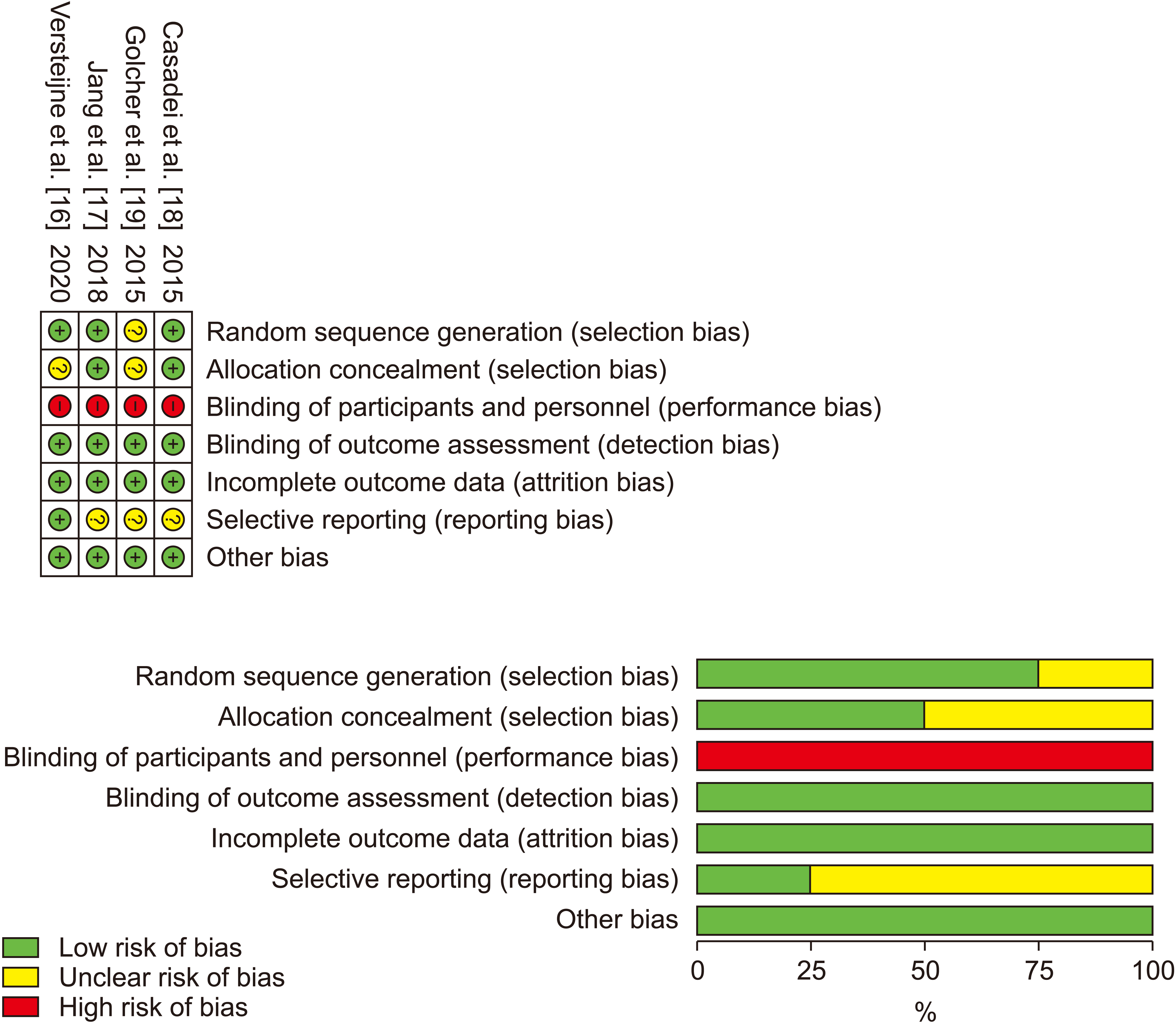
Fig. 3
Results of comparison of meta-analysis model: (A) resection rate; (B) R0 resection rate; and (C) overall survival. SD, standard deviation; CI, confidence interval; M-H, Mantel-Haenszel; IV, inverse variance; CRT, chemoradiotherapy.
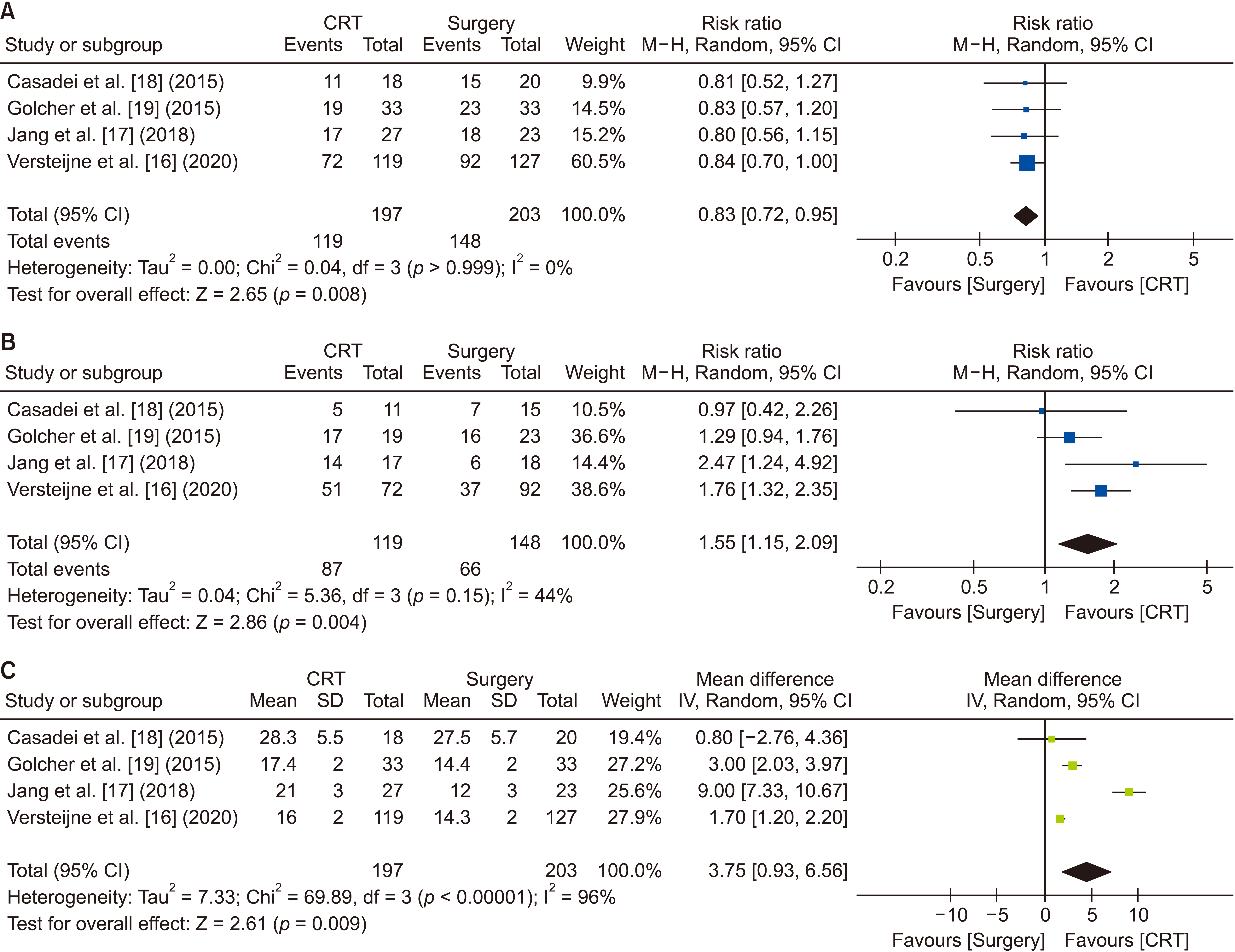
Fig. 4
Results of trial sequential analysis model: (A) resection rate; (B) R0 resection rate; and (C) overall survival. CRT, chemoradiotherapy.
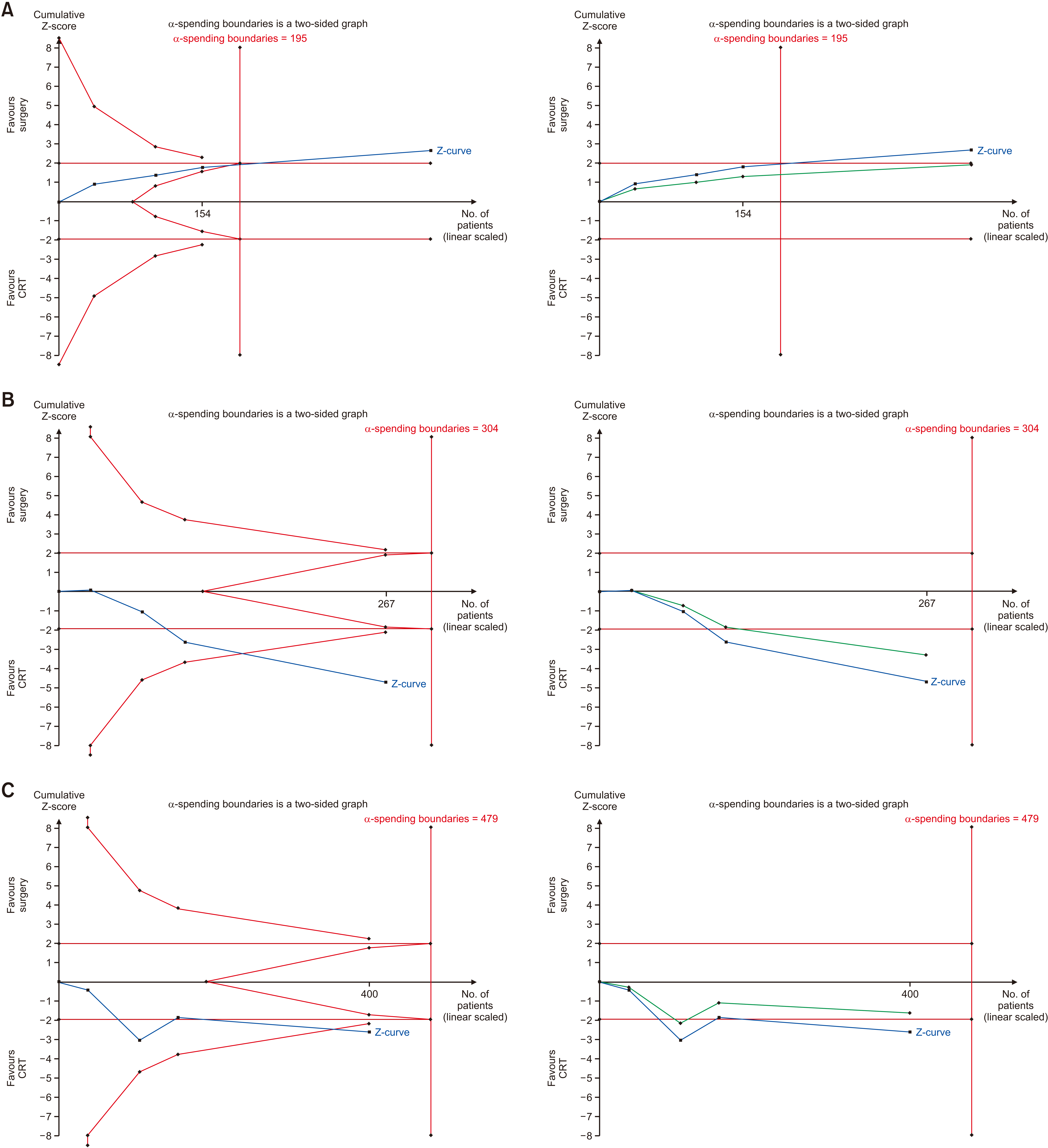
Fig. 5
Results of subgroup analyses for patients with resectable pancreatic cancer and borderline resectable pancreatic cancer: (A) resection rate; (B) R0 resection rate; and (C) overall survival. SD, standard deviation; CI, confidence interval; M-H, Mantel-Haenszel; IV, inverse variance; CRT, chemoradiotherapy.
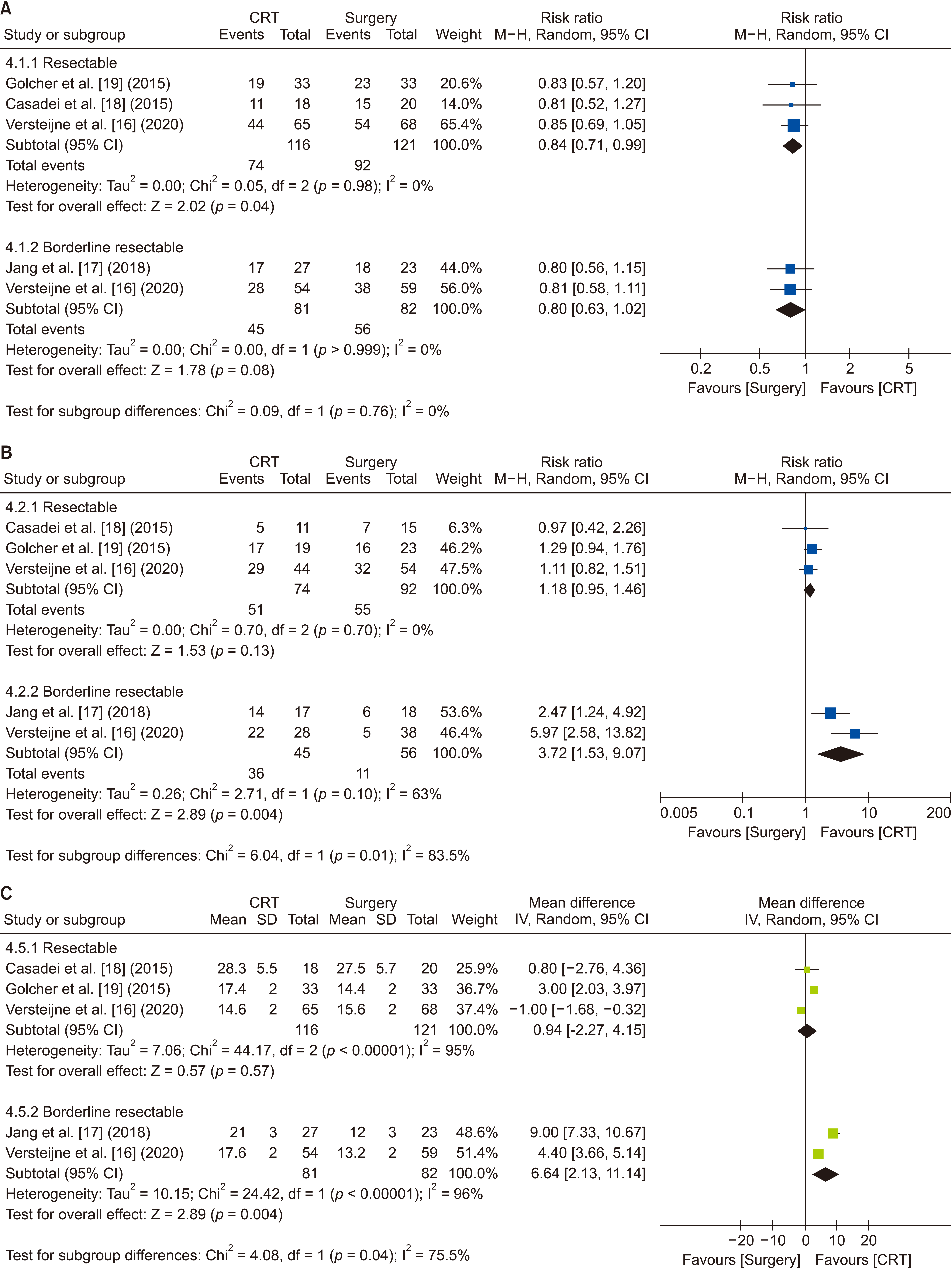
Table 1
Baseline characteristics of included studies and included populations
| Characteristic | Versteijne et al. [16] (2020) | Jang et al. [17] (2018) | Casadei et al. [18] (2015) | Golcher et al. [19] (2015) |
|---|---|---|---|---|
| Country | Netherlands | Republic of Korea | Italy | Germany |
| Journal | J Clin Oncol | Ann Surg | J Gastrointest Surg | Strahlenther Onkol |
| Study design | RCT (phase III) | RCT (phase III) | RCT | RCT (phase II) |
| Study period | 2013–2017 | 2012–2014 | 2007–2014 | 2003–2009 |
| Follow up period (mon) | 27 | 24 | 40 | 61 |
| Number of centres | 16 | 4 | 1 | 8 |
| Description of included population | Patients with histologically confirmed resectable or borderline resectable pancreatic ductal adenocarcinoma | Patients with histologically confirmed borderline resectable pancreatic adenocarcinoma | Patients with histologically confirmed resectable pancreatic adenocarcinoma | Patients with histologically confirmed resectable pancreatic adenocarcinoma |
| Sample size | ||||
| Total | 246 | 50 | 38 | 66 |
| Neoadjuvant CRT | 119 | 27 | 18 | 33 |
| Immediate surgery | 127 | 23 | 20 | 33 |
| Neoadjuvant chemotherapy agent | Gemcitabine | Gemcitabine | Gemcitabine | Gemcitabine + cisplatin |
| Radiotherapy regimen | 15 fractions of 2.4 Gy | 25 fractions of 45 Gy and 5 fractions of 9 Gy | 45 Gy and a boost of 9 Gy (tumor) | 1.8-55.8 Gy (tumor) or 50.4 Gy (regional lymph nodes) |
| Adjuvant chemotherapy agent | Gemcitabine | Gemcitabine | Gemcitabine | Gemcitabine |
| Founding source | Yes | Yes | No | Yes |
| Baseline characteristics (CRT vs immediate surgery) | ||||
| Age | 66 (59–71) vs 67 (60–73) | 59.4 (8.4) vs 58.9 (11.3) | 71.5 (51–78) vs 67.5 (48–79) | 62.5 (33–76) vs 65.1 (46–73) |
| Male | 64/119 vs 74/127 | 17/27 vs 15/23 | 8/18 vs 14/20 | 18/33 vs 17/33 |
| Tumour location | ||||
| Head | 97/119 vs 117/127 | 23/27 vs 17/23 | 15/18 vs 20/20 | 33/33 vs 33/33 |
| Body-tail | 22/119 vs 10/127 | 4/27 vs 6/23 | 3/18 vs 0/20 | 0/33 vs 0/33 |
| Resectable disease | 65/119 vs 68/127 | 0/27 vs 0/23 | 18/18 vs 20/20 | 33/33 vs 33/33 |
| Borderline resectable disease | 54/119 vs 59/127 | 27/27 vs 23/23 | 0/18 vs 0/20 | 0/33 vs 0/33 |
| Adjuvant chemotherapy completion | 34/55 vs 35/65 | 8/14 vs 6/13 | 6/11 vs 15/15 | 7/19 vs 10/23 |




 PDF
PDF Citation
Citation Print
Print



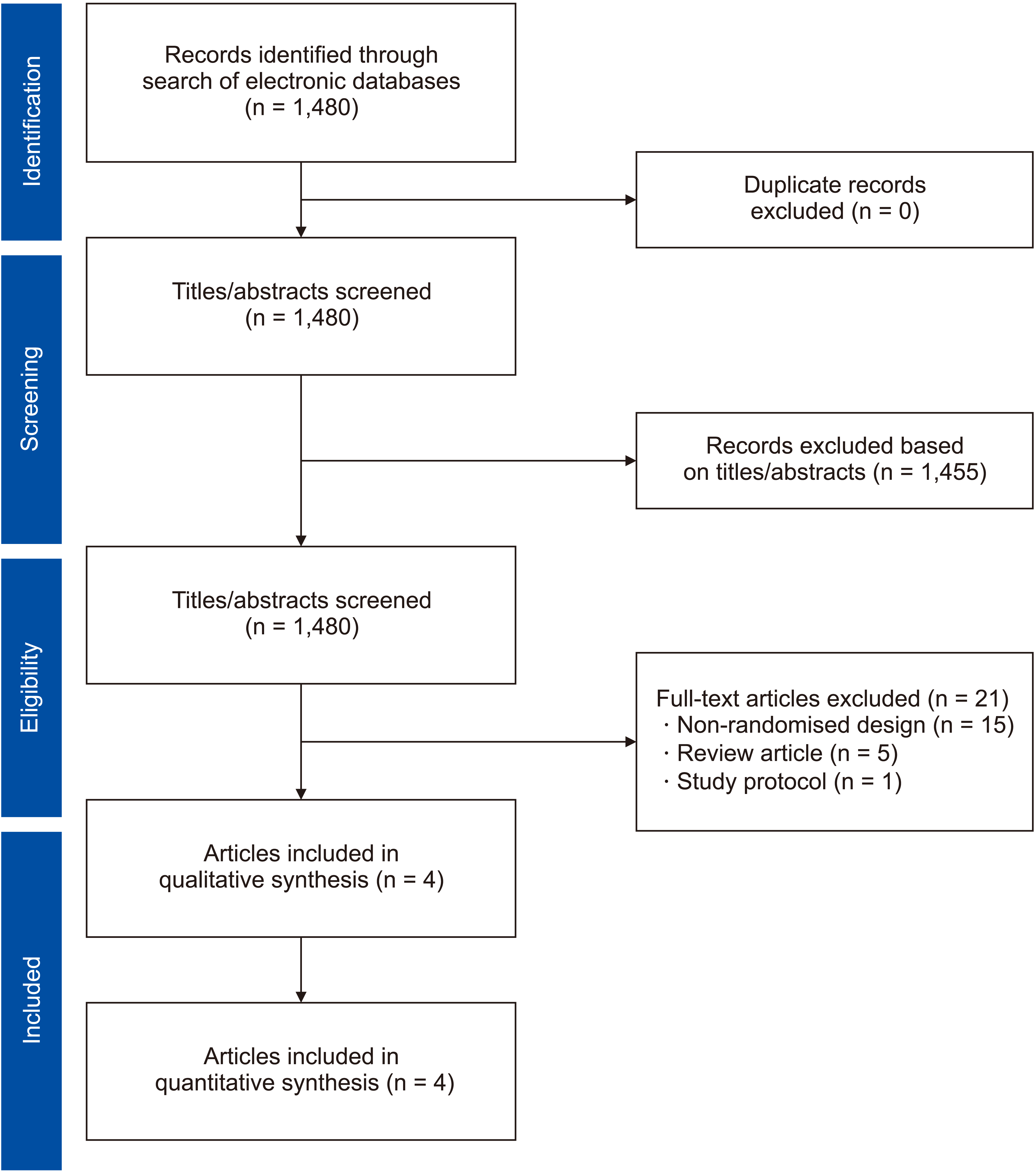
 XML Download
XML Download